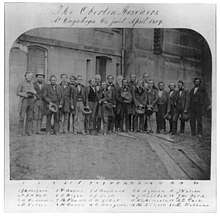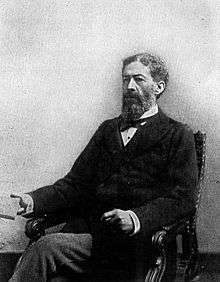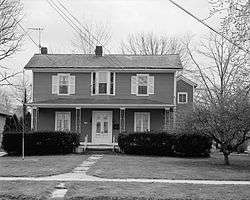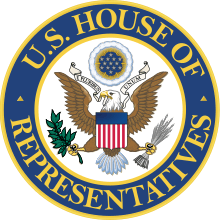John Mercer Langston
John Mercer Langston (December 14, 1829 – November 15, 1897) was an American abolitionist, attorney, educator, activist, diplomat, and politician. An African American, he became the first dean of the law school at Howard University and helped create the department. He was the first president of what is now Virginia State University, a historically black college.
John Langston | |
|---|---|
 | |
| Member of the U.S. House of Representatives from Virginia's 4th district | |
| In office September 23, 1890 – March 3, 1891 | |
| Preceded by | Edward Carrington Venable |
| Succeeded by | James F. Epes |
| United States Minister Resident to the Dominican Republic Acting | |
| In office March 26, 1884 – June 23, 1885 | |
| President | Chester A. Arthur Grover Cleveland |
| Preceded by | Position established |
| Succeeded by | John Thompson |
| United States Minister Resident to Haiti | |
| In office November 27, 1877 – June 30, 1885 | |
| President | Rutherford B. Hayes James A. Garfield Chester A. Arthur Grover Cleveland |
| Preceded by | Ebenezer Bassett |
| Succeeded by | George Washington Williams |
| Personal details | |
| Born | John Mercer Langston December 14, 1829 Louisa, Virginia, U.S. |
| Died | November 15, 1897 (aged 67) Washington, D.C., U.S. |
| Political party | Republican |
| Spouse(s) | Caroline Wall |
| Education | Oberlin College (BA, MA) |
Born free in Virginia to a freedwoman of mixed race and a white planter father, in 1888 Langston was elected to the U.S. Congress as the first representative of color from Virginia. Joseph Hayne Rainey, the black Republican congressman from South Carolina, had been elected in 1870 during the Reconstruction era.
In the Jim Crow era of the later nineteenth century, Langston was one of five African Americans elected to Congress from the South before the former Confederate states passed constitutions and electoral rules from 1890 to 1908 that essentially disenfranchised blacks, excluding them from politics. After that, no African Americans would be elected from the South until 1973, after the federal Voting Rights Act of 1965 was passed to enforce their constitutional franchise rights.
Langston's early career was based in Ohio where, with his older brother Charles Henry Langston, he began his lifelong work for African-American freedom, education, equal rights and suffrage. In 1855 he was one of the first African Americans in the United States elected to public office when elected as a town clerk in Ohio.[1][2][3] The brothers were the grandfather and great-uncle, respectively, of the renowned poet Langston Hughes.
Early life and education
John Mercer Langston was born free in 1829 in Louisa County, Virginia, the youngest of a daughter and three sons of Lucy Jane Langston, a freedwoman of mixed African-American and Native American descent. She may have had ancestry from the regional Pamunkey tribe.[4] Their father was Ralph Quarles, a white planter from England and her former master.[5] Quarles had freed Lucy and their daughter Maria in 1806, in the course of what was a relationship of more than 25 years. After that, their three sons were born free, as their mother was free.[2] John's older brothers were Gideon and Charles Henry.
Lucy had three children with another partner before she moved into the Great House and deepened her relationship with Quarles. Their three sons were born after this. Of the older half-siblings, William Langston was most involved with Quarles's sons. After their father's death, he relocated with them and a guardian to Chillicothe, Ohio (see below).[2]
Before his death, Ralph Quarles arranged for his Quaker friend William Gooch to be made guardian of his children. As requested by Quarles, after the parents both died in 1833 when John Langston was four, Gooch moved with the boys and their half-brother William Langston to Chillicothe, Ohio, in a free state.[6] Quarles had reserved funds for the boys' education. In 1835 the older brothers Gideon and Charles started at the Oberlin preparatory school, where they were the first African-American students to be admitted.[7] Gideon looked much like his father; at the age of 21 Gideon took Quarles as his surname and thereafter was known as Gideon Quarles.[2] During this time, young John Mercer Langston lived in Cincinnati, part of that time with John Woodson and his wife.[8] He also attended the private Gilmore High School.[9]
The youngest Langston followed his brothers, enrolling in the Oberlin preparatory program. John Langston earned a bachelor's degree in 1849 and a master's degree in theology in 1852 from Oberlin College. He is the first known Black to apply to an American law school.[10] Denied admission to law schools in New York and Ohio because of his race, Langston studied law (or "read the law", as was the common practice then) as an apprentice under abolitionist attorney and Republican US congressman Philemon Bliss, in nearby Elyria; he was admitted to the Ohio bar—the first Black— in 1854.[3][10] In Ohio, Langston was closely associated with abolitionist lawyer Sherlock James Andrews.[11]
Marriage and family
In 1854 Langston married Caroline Matilda Wall, at the time a senior at Oberlin College.[12] From North Carolina, she was the daughter of an enslaved mother and Colonel Stephen Wall, a wealthy white planter. Wall freed his mixed-race daughters Sara and Caroline, and sent them to Ohio to be raised in an affluent Quaker household and educated.[13] An intellectual partner of Langston, Caroline had five children with him, one of whom died in childhood.[1]
When Langston was serving as dean of Howard University's Law School, which he developed (see below), he and his family met James Carroll Napier, a student there. Napier married their daughter Nettie, who had graduated from Oberlin College. She later became an important activist. After law school, Napier had returned to Nashville, Tennessee, to set up his law practice before marriage. There he also became a successful businessman and politician. He was appointed in 1911 as Register of the Treasury in President William Howard Taft's administration and was one of four members of his "Black Cabinet".[14]
Career

Together with his older brothers Gideon and Charles, John Langston became active in the abolitionist movement. He helped runaway slaves to escape to the North along the Ohio part of the Underground Railroad. In 1858 he and Charles partnered in leading the Ohio Anti-Slavery Society, with John acting as president and traveling to organize local units, and Charles managing as executive secretary in Cleveland.[1] John played a key role in the influential Oberlin–Wellington Rescue of 1858.
In 1863, when the government approved founding of the United States Colored Troops, John Langston was appointed to recruit African Americans to fight for the Union Army. He enlisted hundreds of men for duty in the Massachusetts Fifty-fourth and Fifty-fifth regiments, in addition to 800 for Ohio's first black regiment. Even before the end of the war, Langston worked for issues of black suffrage and opportunity. He believed that black men's service in the war had earned their right to vote, and that the franchise was fundamental to their creating an equal place in society.
After the war, Langston was appointed inspector general for the Freedmen's Bureau, a Federal organization that assisted freed slaves and tried to oversee labor contracts in the former Confederate states during the Reconstruction era. The Bureau also ran a bank and helped establish schools for freedmen and their children.[3]
In 1864 Langston chaired the committee whose agenda was ratified by the black National Convention: they called for abolition of slavery, support of racial unity and self-help, and equality before the law.[1] To accomplish this program, the convention founded the National Equal Rights League and elected Langston president. He served until 1868. Like the later National Association for the Advancement of Colored People (NAACP), the League was based in state and local organizations. Langston traveled widely to build support. "By war's end, nine state auxiliaries had been established; some twenty months later, Langston could boast of state leagues nearly everywhere."[1]
In 1868 Langston moved to Washington, D.C., to establish and serve as the founding dean of Howard University's law school; this was the first black law school in the country. Appointed acting president of the school in 1872, and vice president of the school, Langston worked to establish strong academic standards. He also engendered the kind of open environment he had known at Oberlin College. Langston was passed over for the permanent position of president of Howard University School of Law; the selection committee refused to disclose the reason.[1]

During 1870, Langston assisted Republican Senator Charles Sumner from Massachusetts with drafting the civil rights bill that was enacted as the Civil Rights Act of 1875. The 43rd Congress of the United States passed the bill in February 1875 and it was signed into law by President Ulysses S. Grant on March 1, 1875.[15]
President Ulysses S. Grant appointed Langston as a member of the Board of Health of the District of Columbia.[16]
In 1877 President Rutherford Hayes appointed Langston as U.S. Minister to Haiti;[16] he also served as chargé d'affaires to the Dominican Republic.[17]
After his diplomatic service, in 1885 Langston returned to the US and Virginia. He was appointed by the state legislature as the first president of Virginia Normal and Collegiate Institute, established as a historically black college (HBCU) and land grant college at Petersburg. (It is now Virginia State University.) There he also began to build a political base.[1]
In 1888, Langston was urged to run for a seat in the U.S. House of Representatives by fellow Republicans, both black and white. Leaders of the biracial Readjuster Party, which had held political power in Virginia from 1879 to 1883, did not support his candidacy.
Langston ran as a Republican and lost to his Democratic opponent. He contested the results of the election because of voter intimidation and fraud.[1] After 18 months, the Congressional elections committee declared Langston the winner, and he took his seat in the U.S. Congress. He served for the remaining six months of the term, but lost his bid for reelection as Democrats had regained political control of Virginia.
Langston was the first black person elected to Congress from Virginia, and he was the last for another century.[1] In a period of increasing disenfranchisement of blacks in the South, he was one of five African Americans elected to Congress during the Jim Crow era of the last decade of the nineteenth century. Two were elected from South Carolina and two from North Carolina. After them, no African Americans would be elected to Congress from the South until 1972, after passage of the Voting Rights Act to enforce the exercise of constitutional franchise rights for all citizens.[18]
In 1890 Langston was named as a member of the board of trustees of St. Paul Normal and Industrial School, a historically black college, when it was incorporated by the Virginia General Assembly. In this period, he also wrote his autobiography, which he published in 1894.
From 1891 until his death in 1897, he practiced law in Washington, D.C. He died at his home, Hillside Cottage at 2225 Fourth Street NW in Washington, DC, on the morning of November 15.[19][20] He was first buried at Harmony Cemetery in Maryland. Although there was discussion of reinterring him in Nashville, he was reinterred at Woodlawn Cemetery in Washington, DC.

Langston was the great-uncle of the poet James Mercer Langston Hughes (called Langston Hughes).[13]
Legacy and honors
The John Mercer Langston House in Oberlin, Ohio, has been designated as a National Historic Landmark.
The town of Langston, Oklahoma, founded in 1890 as an all-black town, was named for him. The historically black college in the town, founded in 1897 as the Oklahoma Colored Agricultural and Normal University, was renamed Langston University in honor of John Mercer Langston in 1941.
John Mercer Langston Elementary School at 33 P Street NW in Washington, D.C. was named in his honor. It opened in 1902 as a school for black students and remained open until 1993. In 1997 the building served as a homeless shelter, but it has mostly sat empty since closing.[21]
Works
Selected works:
- From the Virginia Plantation to the National Capitol; Or, the First and Only Negro Representative in Congress From the Old Dominion. American Publishing Company. 1894.
- Freedom and Citizenship: Selected Lectures of Hon. John Mercer Langston. Whitefish, MT: Kessinger Publishing Company. 2007 [1883].
See also
Notes
- William Cheek and Aimee Lee Cheek, "John Mercer Langston: Principle and Politics" Archived 12 January 2014 at the Wayback Machine, in Leon F. Litwack and August Meier, eds, Black Leaders of the Nineteenth Century, University of Illinois, 1991, pp. 110-114, 118.
- Cheek 1989, pp. 11-12.
- Foner, Philip Sheldon; Branham, Robert J. (1997). Lift Every Voice: African American Oratory, 1787-1900. University Alabama Press. pp. 273–274. ISBN 978-0-8173-0906-0.
- Rountree, Helen C. Pocahontas's People: The Powhatan Indians of Virginia Through Four Centuries. Vol. 196. University of Oklahoma Press, 1990. pp173-174
- Quarles was the descendant of the 17th-century English poet Francis Quarles, Wagner (1973), p. 386.
- Frederick J. Blue, No Taint of Compromise: Crusaders in Antislavery Politics Archived 31 May 2016 at the Wayback Machine, Louisiana State University Press, 2006, p. 66.
- Richard B. Sheridan, "Charles Henry Langston and the African American Struggle in Kansas" Archived 6 August 2018 at the Wayback Machine, Kansas State History, Winter 1999, retrieved December 15, 2008.
- John Woodson was a brother of Lewis and Sarah Jane. John Woodson was married to Eveline Clark, a relative of Peter H. Clark. Peter H. Clark and John Langston became lifelong friends and political collaborators. Sarah Jane Woodson, like Langston, graduated from Oberlin College before the Civil War. Langston's brother Gideon married Peter H. Clark's older sister. Nikki Taylor, America's First Black Socialist, Peter H. Clark, (University Press of Kentucky, 2013),28.
- Shotwell, John Brough (1902). A history of the schools of Cincinnati. The School life company. pp. 453–455. Archived from the original on 16 May 2020. Retrieved 13 March 2020.
- Smith, Jr., J. Clay (1993). Emancipation: The Making of the Black Lawyer, 1844-1944. University of Pennsylvania Press. p. 407. ISBN 0812231813.
- Cheek 1991, p132
- "John Mercer Langston (1829-1897)" Archived 27 December 2005 at the Wayback Machine, Oberlin College, retrieved December 15, 2008.
- "John Mercer Langston" Archived 16 September 2013 at the Wayback Machine, Black Past, retrieved December 15, 2008.
- Gatewood, Willard B. Aristocrats of Color: The Black Elite 1880–1920 (p). University of Arkansas Press, 1990. p242
- John Mercer Langston, Representative, 1890–1891, Republican from Virginia, Black Americans in Congress series, archived from the original on July 2, 2012, retrieved November 12, 2012
- Turkel, Stanley (2009). Heroes of the American Reconstruction: Profiles of Sixteen Educators, Politicians and Activists. McFarland. p. 81. ISBN 978-0-7864-4250-8. Archived from the original on 17 May 2018. Retrieved 6 March 2016.
- Tillman, Linda C. (2008). The Sage Handbook of African American Education. Sage Publications. p. 44. ISBN 978-1-4129-3743-6. Archived from the original on 13 June 2013. Retrieved 6 March 2016.
- "The Negroes' Temporary Farewell: Jim Crow and the Exclusion of African Americans from Congress, 1887–1929" Archived April 21, 2012, at the Wayback Machine, Black Americans in Congress, US Congress, retrieved June 5, 2012.
- Fortune, T. Thomas (November 21, 1897). "John Mercer Langston" (PDF). The New York Sun. Archived (PDF) from the original on 19 August 2016. Retrieved June 14, 2016.
- "Langston is Dead" (PDF). The Washington Bee. November 20, 1897. Archived (PDF) from the original on 19 August 2016. Retrieved June 14, 2016.
- "Historic Landmark Designation Case No. 08-10" (PDF). Archived from the original (PDF) on 5 August 2016. Retrieved 14 June 2016.
References
- Cheek, William Francis, and Aimee Lee Cheek, John Mercer Langston and the Fight for Black Freedom, 1829-65. Urbana and Chicago: University of Illinois Press, 1989.
- Wagner, Jean, Black Poets of the United States: From Paul Laurence Dunbar to Langston Hughes, University of Illinois Press, 1973, ISBN 0-252-00341-1.
- William Cheek, "A Negro Runs for Congress: John Mercer Langston and the Virginia Campaign of 1888", The Journal of Negro History, 52 (January 1967).
- W. Cheek, "John Mercer Langston: Black Protest Leader and Abolitionist", Civil War History 16 (March 1970).
Attribution:

|title=(help)
External links
| Wikimedia Commons has media related to John Mercer Langston. |
| Wikisource has original text related to this article: |
- "John Mercer Langston", Congressional Biography
- Langston Biography, Black Americans in Congress, 1870-2007
- "John Mercer Langston", Oberlin College biography
- John Mercer Langston Speeches, Oberlin College speech collection
- Kevin Mérida, "The 'Obama Before Obama'", Washington Post, June 7, 2008
- "Biography of John Mercer Langston" including youthful photograph, AfricanAmericans.com
- Langston High School Continuation Program in Arlington, Virginia
| Academic offices | ||
|---|---|---|
| New office | Dean of Howard University School of Law 1869–1875 |
Succeeded by John Cook |
| President of Virginia State University 1886–1887 |
Succeeded by James Johnston | |
| U.S. House of Representatives | ||
| Preceded by Edward Carrington Venable |
Member of the U.S. House of Representatives from Virginia's 4th congressional district 1890–1891 |
Succeeded by James F. Epes |
| Diplomatic posts | ||
| Preceded by Ebenezer Bassett |
United States Minister Resident to Haiti 1877–1885 |
Succeeded by George Washington Williams |
| New office | United States Minister Resident to the Dominican Republic Acting 1884–1885 |
Succeeded by John Thompson |

